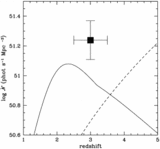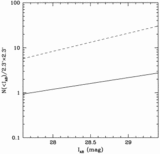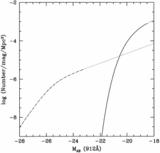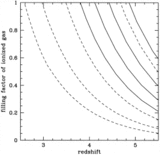Image Details
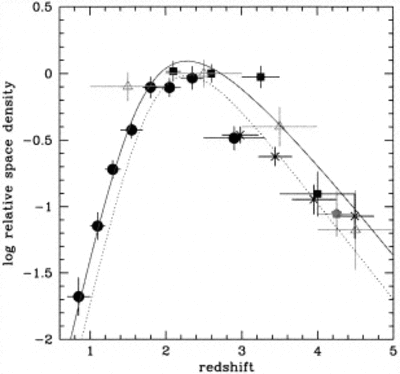
Caption: Fig. 1.
Comoving space density of bright QSOs as a function of redshift for ﹩( h_{50},\,q_{0},\,\alpha _{s}) =( 1.0,\,0.5,\,0.5) ﹩. The data points with error bars are taken from Hartwick & Schade (1990; circles), Warren et al. (1994; squares), Schmidt et al. (1995; crosses), and Kennefick et al. (1995; pentagons). The points have been normalized to the ﹩z=2.5﹩ space density of quasars with ﹩M_{B}< M_{\mathrm{lim}\,}=-26﹩ (﹩M_{B}< M_{\mathrm{lim}\,}=-27﹩ in the case of Kennifick et al. 1995) as given by Warren et al. (1994). The curves (solid line for ﹩M_{\mathrm{lim}\,}=-26﹩, and dotted line for ﹩M_{\mathrm{lim}\,}=-27﹩) have been computed from eqs. (12), (13), and (14), with ﹩\mathrm{log}\,\,( \phi _{*}/ \mathrm{Gpc}\,^{-3}) =2.95﹩, ﹩\beta _{1}=1.64﹩, ﹩\beta _{2}=3.52﹩, ﹩M_{*}( 0) =-22.35﹩, ﹩z_{*}=1.9﹩, ﹩\zeta =2.58﹩, and ﹩\xi =3.16﹩, and have been normalized to Warren et al. (1994) as well. The triangles show the space density (normalized to the peak) of the Parkes flat‐spectrum radio‐loud quasars with ﹩P> 7.2\times 10^{26}﹩ W Hz−1 sr−1 (Hook et al. 1998).
Copyright and Terms & Conditions
© 1999. The American Astronomical Society. All rights reserved. Printed in U.S.A.


